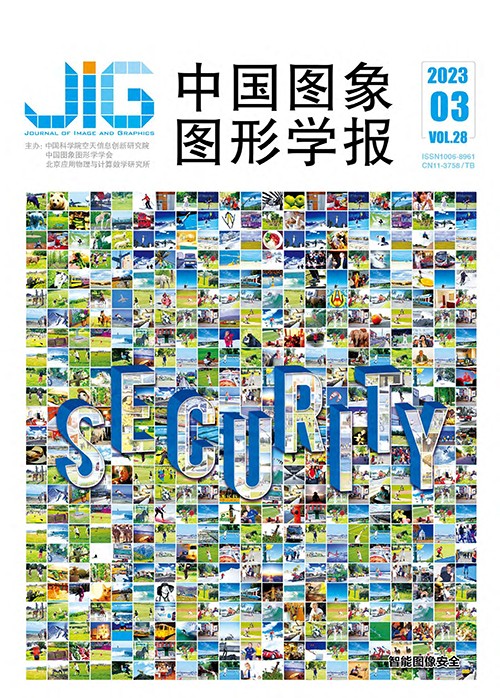
结合面部纹理和前/背景差异的人脸活体检测
摘 要
目的 人脸活体检测是人脸识别技术安全的重要保障,而背景环境的负面干扰是限制检测系统性能的关键问题。针对这一问题,提出了一种基于面部纹理和前/背景差异分析的人脸活体检测模型。方法 首先,基于新型骨干网络构建面部纹理分析模块,为模型提供充足的面部纹理信息,减缓模型受背景差异的负面干扰;接着,结合边缘检测算法思想对前/背景差异分析模块的卷积核重新改写,以此突出面部边缘的细节特征;最后,设计注意力特征融合模块将两个分流模块有机结合,提升模型在各种复杂环境下的可靠性。结果 在CASIA-MFSD(CASIA-mobile face spoofing dataset)、Replay-Attack和OULU-NPU等3个数据集上做了多组对比实验,在CASIA-MFSD数据集上的等错误率(equal error rate,EER)为0.19%,在Replay-Attack数据集上的等错误率和半错误率(half total error rate,HTER)均为0.00%和0.00%,在OULU-NPU数据集4个协议上的平均分类错误率(average classification error rate,ACER)分别达到0.6%、1.9%、1.9±1.2%和3.7±1.1%。结论 在人脸反欺诈模型中融合前/背景差异信息和面部纹理信息,可有效减缓背景环境带来的负面干扰,提升模型的鲁棒性。所提模型在背景复杂、欺诈攻击方式尖锐的数据集上均取得较低的错误率,较同类先进算法具有明显优势。
关键词
Human facial texture and fore-background differences-relevant anti-spoofing detection
Zhu Jianqiu1, Hua Yang1, Song Xiaoning1, Wu Xiaojun1, Feng Zhenhua2(1.School of Artificial Intelligence and Computer Science, Jiangnan University, Wuxi 214122, China;2.Department of Computer Science, University of Surrey, Guildford GU2 7XH, UK) Abstract
Objective Human-relevant face recognition is often vulnerable for a spoofing attacks-involved system. In this scenario, face information-verified is projected for that. To optimize face recognition system, face anti-spoofing (FAS) has been concerned in recent years. It can provide a security barrier for face recognition systems in practice. Conventional FAS methods are still restricted by handcrafted features and shallow classifiers, and end-to-end trained deep neural networks. Specific attacks are dealt with only because they are sensitive and vulnerable to facial appearance variations in pose, expression, illumination, makeup, occlusion, etc.. In contrast, deep neural network (DNN) based face anti-spoofing algorithms have the capability in distinguishing real and spoofing faces in unconstrained scenarios. Nevertheless, the existing deep learning based FAS methods also have two problems to be challenged: 1) a universal convolution layer and computational complexity and 2) complex background distractions. Although the diversity of background is beneficial to improve the robustness of a trained deep neural network, the performance may degrade when the background contour and exposure degree become the key for face anti-spoofing. For example, a trained model may rely on background features severely and pay less attention to the facial area, resulting in poor generalization for unclear scenarios. Method To resolve the issues mentioned above, we develop a novel facial texture information-based face anti-spoofing model and its relevant fore-background difference analysis. The proposed method has two main modules: 1) facial texture analysis (FTA) and 2) fore-background difference analysis (FBDA). First, the FTA is used to extract rich facial information for FAS, and a mask is used to process an input image in terms of face region-activated only. Next, the ConvNeXt is used to extract facial features-masked. It is required to be coordinated with FBDA although FTA-extracted facial information can alleviate background differences-introduced interference effectively. The challenge is that FTA may overfit to the training data due to the lack of background information. Third, to reduce computational complexity of the convolution kernel and eliminate the redundancy information of the extracted features, the convolution kernel of a backbone network is redesigned in terms of the mechanism of edge detection in the FBDA module. Our convolution kernels proposed consists of 1) sobel horizontal (vertical) convolution kernels for detecting horizontal (vertical) edge information and 2) a convex convolution kernel for detecting face contours. To improve the efficiency of a deep network, the proposed kernels have less parameter compared to the universal convolution kernel. Furthermore, the network can capture more fine-grained information of an input image in terms of the proposed convolution kernels-cascaded. Finally, to highlight the potentials of these two modules, an attention fusion module is designed and used to balance the contribution of the extracted facial texture information for spoofing detection. In particular, to improve the reliability and robustness of the proposed method, a multiple scenario-oriented attention fusion module is developed. To validate the proposed method, three kinds of datasets of are used, including CASIA-MFSD dataset, Replay-Attack dataset, and OULU-NPU dataset. In our experiments, comparative analysis is carried out based on the same evaluation metrics of those are 1) equal error rate (EER), 2) half total error rate (HTER), and 3) average classification error rate (ACER). Result Our optimization achieves 0.19% in terms of EER on the CASIA-MFSD dataset, 0.00% in EER and 0.00% in HTER on the Replay-Attack dataset, and 0.6%, 1.9%, 1.9±1.2%, and 3.7±1.1% in terms of ACER on the four subsets of the OULU-NPU dataset. To evaluate the performance of our method for unclear environments, the cross-dataset evaluations are employed on CASIA-MFSD and Replay-Attack as well. Trained on CASIA-MFSD, it achieves 17.1% in HTER on the Replay-Attack test set. Trained on Replay-Attack, it achieves 27.4% on the CASIA-MFSD test set in terms of HTER. The comparative analysis is demonstrated that our optimization has its lower error rates on several complex data sets and performs better for unclear environments. Conclusion A novel face anti-spoofing model is developed using the front/background difference information and facial texture information, which can effectively alleviate the difficulties posed by complex background, resulting in better robustness of a trained deep network. To harness a new strategy for practical applications of face spoofing detection, our algorithm is proposed. It can improve the generalization capability of the trained model under unclear scenarios in accordance with more attention weight of the extracted facial texture features. Limitation the accuracy of our method is still not optimal for the datasets for a single background.
Keywords
face anti-spoofing detection(FAS) edge detection texture feature attention feature fusion face recognition
|



 中国图象图形学报 │ 京ICP备05080539号-4 │ 本系统由
中国图象图形学报 │ 京ICP备05080539号-4 │ 本系统由